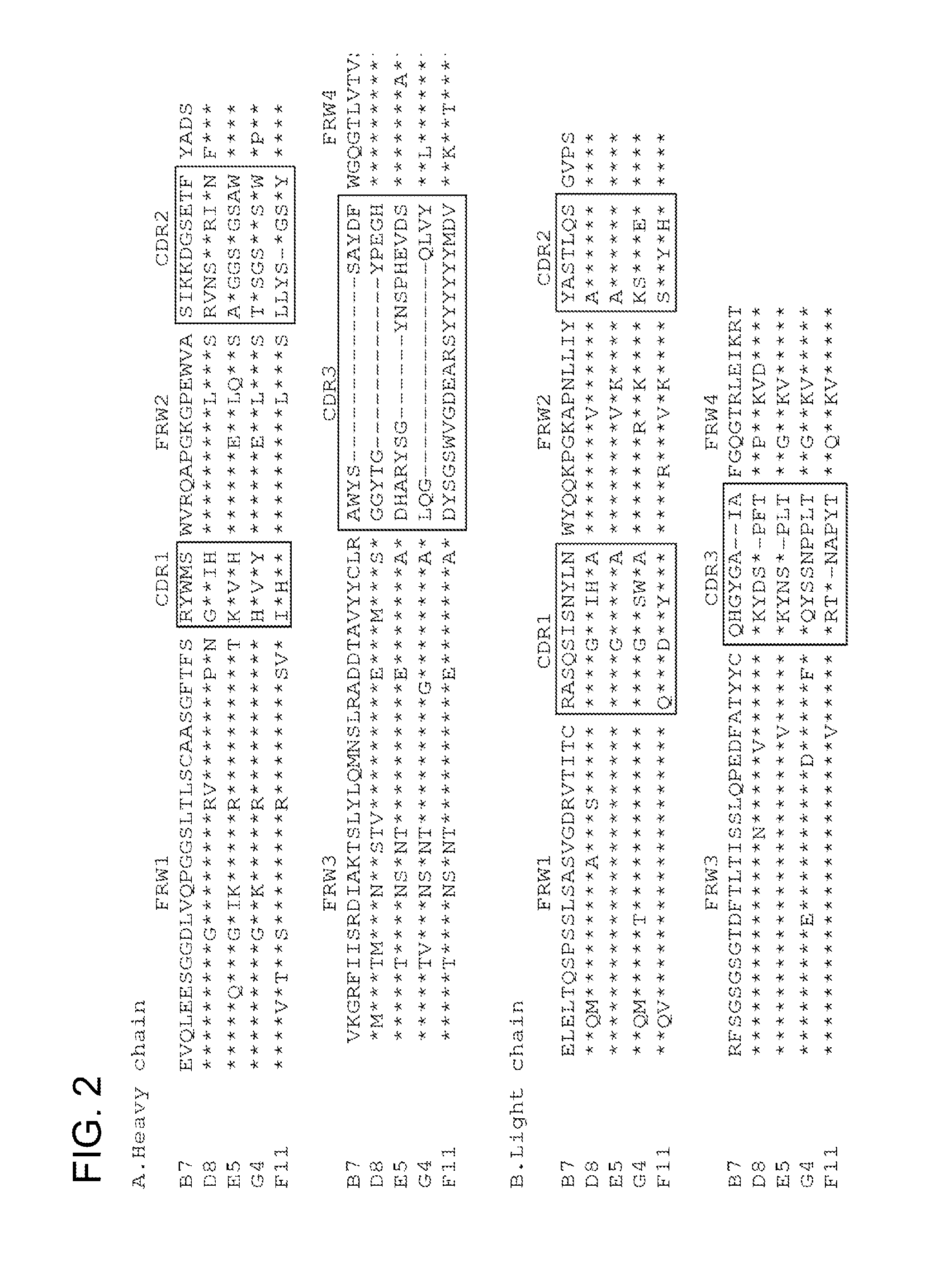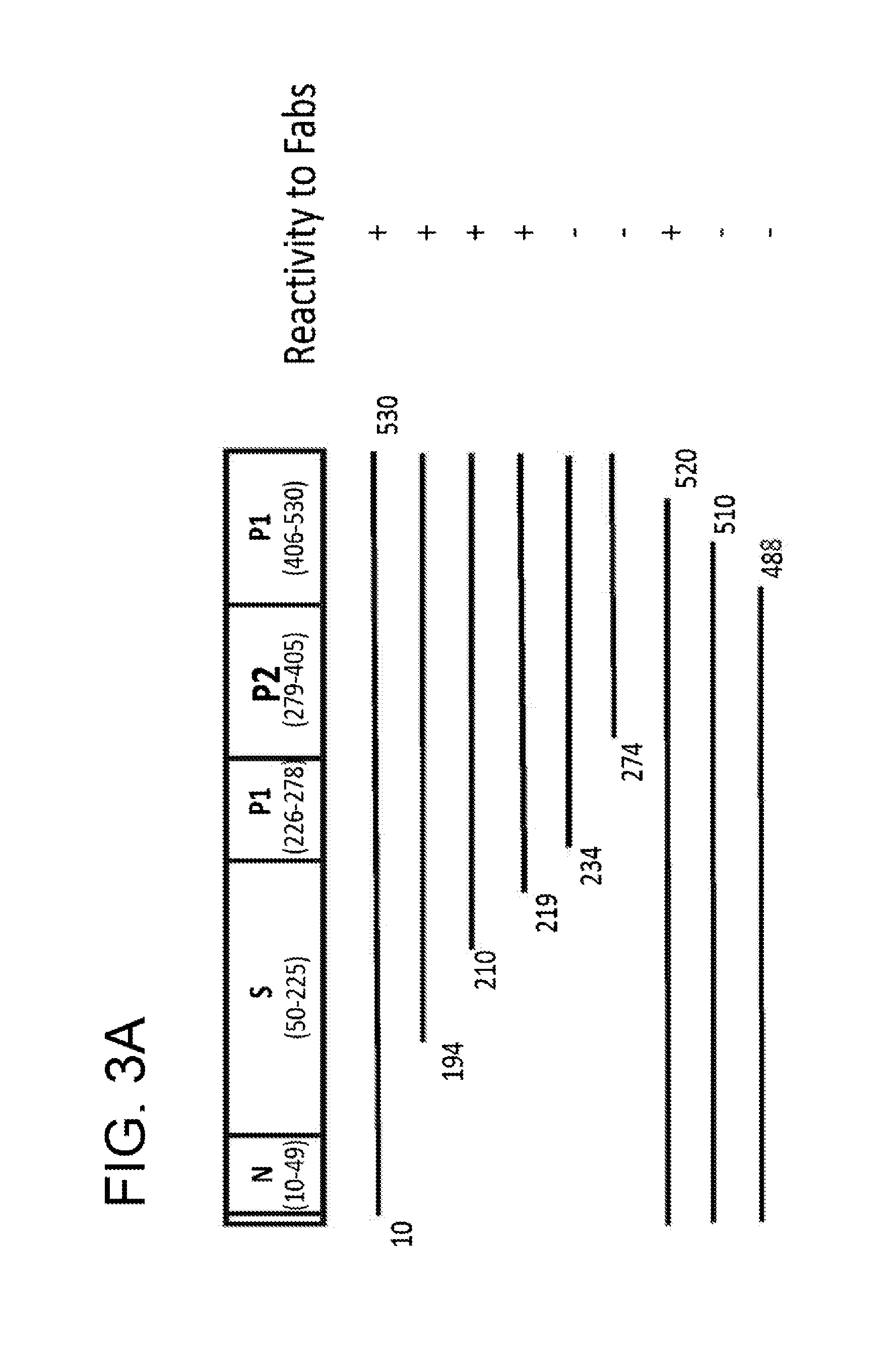Monoclonal antibodies that neutralize a norovirus
a norovirus and monoclonal antibody technology, applied in the field of antibodies, can solve the problems of insufficient understanding of immune correlates of protection, no vaccines or specific antiviral therapies available for treatment, etc., and achieve the effect of reducing viral titer
- Summary
- Abstract
- Description
- Claims
- Application Information
AI Technical Summary
Benefits of technology
Problems solved by technology
Method used
Image
Examples
example 1
Materials and Methods
[0431]Immunization of Chimpanzees with NV and Construction of Combinatorial Fab Antibody Library:
[0432]Chimpanzee 1618 was inoculated orally with 101 50% chimpanzee infectious doses (CID50) of prototype NV in a stool filtrate (preparation 8 FIIa F / T, 1976) and were boosted intravenously with NV recombinant viral like particles (rVLPs). Bone marrow was aspirated from the chimpanzee at days 60, 74 and 88 after boost. Bone marrow-derived lymphocytes were prepared by centrifugation on a Ficoll-Hypaque gradient (GE Healthcare, Piscataway, N.J.) and were used for construction of a combinatorial Fab phage display library as described (Chen et al., 2007, J Virol 81:8989-95; Chen et al., 2006, Proc Natl Acad Sci USA 103:1882-7). A Fab phage display library containing γ1 heavy chain and K, λ light chain with a diversity of >108 was constructed.
[0433]Panning of Phage Library and Selection of NV-Specific Fabs:
[0434]Phages were produced from the library as described (Chen et...
example 2
Isolation and Characterization of NV-Specific Fabs
[0469]A phage Fab display library constructed from chimpanzees immunized with NV was panned for three cycles against NV rVLPs. The phage-Fab clones specific to NV were identified by phage ELISA. The sequencing analysis of the variable domain of heavy (VH) and light (VL) chains showed that four unique clones, B7, D8, E5 and G4, specific to NV were recovered. By immortalization of memory B-cells, an additional clone, F11 was recovered. These positive clones were subsequently converted to produce soluble Fabs. Each soluble Fab was confirmed for its specific binding to NV as they only bound to NV rVLPs, but not to BSA, phosphorylase b, thyroglobulin, or lysozyme. The ELISA binding profile of a representative Fab is shown in FIG. 1A.
[0470]To determine the binding spectrum of the anti-NV Fabs, binding assays were performed in an ELISA with rVLPs derived from representative human NoVs: NV (GI.1), NV-2007 (GI.1), Hawaii (GII.1) and MD-145 (G...
example 3
Anti-NV Fabs Recognize Conformational Epitopes on NV VP1
[0477]It was first determined that none of the anti-NV Fabs was reactive with denatured NV rVLP protein in Western blots, indicating that the Fabs likely recognize conformational epitopes present in hetero-oligomeric forms of the capsid protein. To map the conformational epitopes, a series of constructs that expressed full-length and truncated forms of the NV VP1 were generated to localize the binding sites of the antibodies by a radioimmunoprecipitation assay (RIPA). Fabs B7, D8, E5 and G4 displayed the same binding pattern shown in FIG. 3A. Deletion of the N-terminal region of VP1 through most of the S domain did not affect Fab binding. However, deletion into the P domain from either the N- or C-terminus resulted in complete abolishment of antibody binding. This result suggests that anti-NV Fabs bind to conformational epitopes that require presentation in the context of virtually entire P domain of VP1.
[0478]To address whethe...
PUM
| Property | Measurement | Unit |
|---|---|---|
| equilibrium constant | aaaaa | aaaaa |
| concentration | aaaaa | aaaaa |
| concentration | aaaaa | aaaaa |
Abstract
Description
Claims
Application Information
 Login to View More
Login to View More - R&D
- Intellectual Property
- Life Sciences
- Materials
- Tech Scout
- Unparalleled Data Quality
- Higher Quality Content
- 60% Fewer Hallucinations
Browse by: Latest US Patents, China's latest patents, Technical Efficacy Thesaurus, Application Domain, Technology Topic, Popular Technical Reports.
© 2025 PatSnap. All rights reserved.Legal|Privacy policy|Modern Slavery Act Transparency Statement|Sitemap|About US| Contact US: help@patsnap.com



